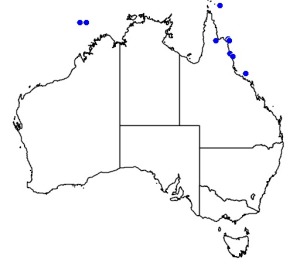
©Victor Huertas: One of many Holothuria (Acanthotrapeza) coluber spawning between 1530 and 1600 in the Lizard Island lagoon on 20 Dec 2018.
Colours
Distinguishing features
Holothuria (Acanthotrapeza) coluber is an extremely long, black holothurian with papillae distinctively tipped with pale yellow and 20 yellow feeding tentacles. The whole animal is rarely seen as the posterior end is usually tucked within the reef. The body wall is tough and knobbly. No Cuverian tubules.
Size
- Up to 100 cm (estimated length)
Depth range
- Depth range data is not yet available.
Synonyms
Similar taxa
-
Animalia:
species: Holothuria (Mertensiothuria) leucospilota
is also a long, black, pliable holothuroid found on reef flats. While it can be extremely common in some locations, it is very rare in the Lizard Island area. It is easily distinguished from Holothuria (Acanthotrapeza) coluber by its black mouth tentacles (vs. yellow) and it ejects long, thin Cuvierian tubules (vs. no such tubules).
Distribution
Distribution and habitat preferences
Holothuria (Acanthotrapeza) coluber is common in shallow reef-flat areas.
Behaviour
Many individuals of this species spawned at about 5 pm on 1 January 2002 on the rubble reef in front of the Station. The posterior ends were wedged into the reef or under rubble as usual and the anterior ends were raised 30 to 50 cm off the substrate. They were very unstable, falling over then rising again repeatedly. Spawn was ejected in small puffs of about 1 second duration with 30 to 50 seconds between puffs. Spawn was very fine and milky - eggs not discernable. Observation by Anne Hoggett.
Spawning by many individuals was also observed by Victor Huertas between 3.30 and 4 pm on 20 Dec 2018 (see photo and record in LIFG).
Web resources
References
- Bakus, G.J. (1981). Chemical defense mechanisms on the Great Barrier Reef, Science, 211: 497-499. LIRS catalog number 41.
- Cannon, L.R.G. and H. Silver (1986). Sea Cucumbers of Northern Australia Queensland Museum, Brisbane. LIRS catalog number 229.
- Purcell, S.W., Y. Samyn and C. Conand (2012). Commercially important sea cucumbers of the world 150 pp., 30 pl. Food and Agriculture Organization of the United Nations, Rome.
- View all references




